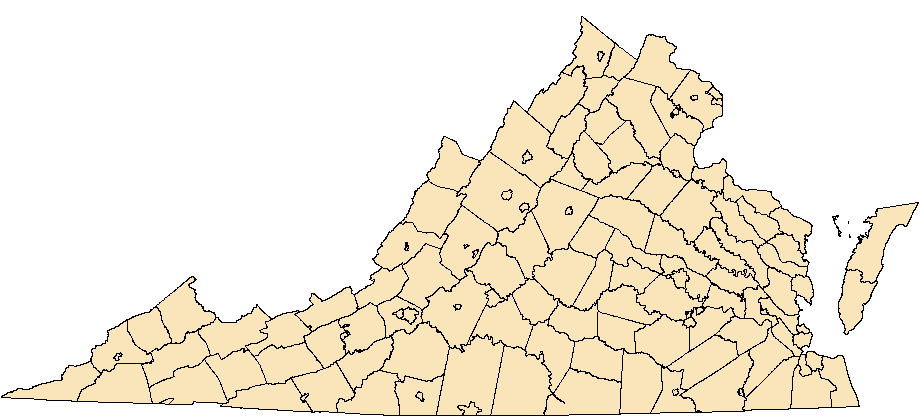Speyeria idalia (Drury, 1773)
Regal Fritillary
NatureServe Global Rank: G3
Virginia State Rank: S1
VA DGIF Tier: I
Federal Legal Status: None
Virginia Legal Status: None
Description: The Regal Fritillary is a very large butterfly with striking colors and slight sexual dimorphism. The smaller males have orange dorsal front wings with black markings and dark ventral hind wings with an iridescent sheen having white and orange spots. The dorsal side of the females have extended dark regions near the apex and outside edge of the front wing, and have only white spots on the hind wing. Both have dark borders on the front wing with checkered fringes. The ventral side is mainly dark with silvery spots.
Similar species: Superficially similar to other Fritillary species, the Regal Fritillary is more striking and has a greater degree of contrast between the base colors of the dorsal front and back wings. The dark markings on the dorsal front wings are greatly reduced compared to other species and the spotting on the hind wing is like no other Fritillary species. The ventral side is also more striking in color contrast than other Fritillary species.
North American Range: Once found in many regions, the range of the Regal Fritillary has changed dramatically in the last one hundred years. There are pockets of the species in the grasslands of Montana, North Dakota, and down through Colorado. They are no longer as common as they were on the East Coast but are still found in Western Pennsylvania and Virginia.
VA Observations by Locality: Alleghany | Augusta | Buchanan | Carroll | Craig | Fairfax | Fauquier | Floyd | Frederick | Grayson | Greene | Highland | Lee | Madison | Nelson | Orange | Page | Patrick | Prince William | Pulaski | Rappahannock | Roanoke | Rockbridge | Russell | Salem, City of | Shenandoah | Smyth | Spotsylvania | Stafford | Tazewell | Warren | Washington | Wythe | Albemarle | Amherst | Augusta | Bedford | Carroll | Clarke | Craig | Fairfax | Fauquier | Giles | Highland | Lee | Loudoun | Madison | Montgomery | Nelson | Orange | Page | Prince William | Rappahannock | Roanoke | Rockbridge | Rockingham | Washington | Wythe | Grayson | Loudoun | Montgomery | Page | Pulaski
































































Flight season and broods: The Regal Fritillary has one brood with a short season of mid June through mid August.
Habitat and Food Plants: This species prefers to occupy areas with tall grass such as prairies, fields, grasslands, and bogs. It may have close ties to undisturbed native grasslands. Like the Diana Fritillary (S. diana), the Regal uses members of the Violet (Viola) as its host plant. In Virginia, its plant of choice is the Birds Food Violet (Viola pedata).
Behavior and Ecology: Adults patrol as many other Fritillary species, but will also land and perch on grasses, etc., for longer periods of time than similar species. The Regal females drop a sizeable number of eggs on the ground on or around host plant. The caterpillars are born late in the season and are able to overwinter unfed. In the spring, they will consume the leaves and flower parts of the Violets. The adults feed on nectar from Thistle (Cirsium, Milkweeds (Aesclepias, and Red Clover (Trifolium) plants.
Population trend and potential threats: This species is globally insecure. Once dense on the East Coast, the species is now only found in small populations in Pennsylvania and Virginia.
Management practices: Management practices, including monitoring and improving habitat in public and private lands, has been an ongoing process.
References: Allen, T. J. 1997. The Butterflies of West Virginia and their Caterpillars. University of Pittsburg Press. 388pp.
Cech, R. and G. Tudor. 2005. Butterflies of the East Coast. Pg. 156. Princeton University Press.
Opler, P. A. and G.O. Krizek. 1984. Butterflies East of the Great Plains, Johns Hopkins University Press.
Pyle, R. M. 1981. Field Guide to North American Butterflies. National Audubon Society.
Williams, E. H. 2002. Fritillaries. Eastern American Butterflies, 10(2). Pgs. 18-25.
Virginia Department of Conservation and Recreation, Natural Heritage Program, 600 E. Main St., 24th Floor, Richmond, VA 23219
This atlas was compiled
by the VA Natural Heritage Program with funds provided by the VA Dept. of Game and Inland Fisheries through a state wildlife grant
from U.S. Fish and Wildlife Service
Questions/Comments? Check the contacts page |
Internet Privacy Policy Statement
Last Modified: Friday, 26 February 2021, 03:21:56 PM